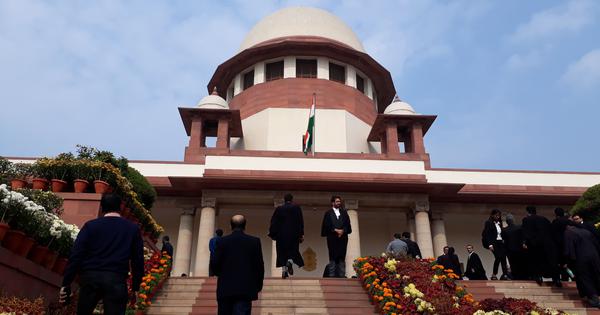
In the early 2000s, focused efforts were directed towards comprehensive computerisation. A centrally sponsored scheme aimed at computerising 700 city courts across Delhi, Kolkata, Mumbai and Chennai was initiated between 2003 and 2004. The focus at this stage was primarily on back-office tasks. The first-ever e-Committee to formulate a National Policy on the computerisation of the Indian Judiciary was constituted by the CJI in July 2004. This was chaired by Dr GC Bharuka J.
A strategic plan was presented to the then CJI RC Lahoti J in May 2005. This laid the foundation for a national policy and action plan, emphasising judicial autonomy in technology adoption. The Department of Justice (DoJ) of the Union Government identified 14,938 courts in the districts across the country for computerisation in three stages, emphasising citizen-centric services, software development models and the migration to cloud infrastructure. The project was launched in October 2005 as one of the centrally sponsored schemes, and in June 2006, it was declared as one of the Mission Mode Projects under the National e-governance Plan. After financial sanction was accorded in February 2007, Phase I of the e-Courts Project was formally launched in July 2007. A Vision Statement and Action Plan was announced in 2009 as a result of the deliberations at the Conference of Chief Ministers and Chief Justices (CJs) held that year. It also set out elaborate measures for the digitalisation of courts.
As regards the deployment of software, NIC decided in 1997 itself to opt for Free and Open Source Software (FOSS), specifically the Linux system. The push to have a common Case Information System (CIS) software application for the e-Courts Project came from the e-Committee in May 2008. This was done by the Open Technology Centre of the NIC using a Linux-based platform with the Ubuntu operating system. Following the success of the pilot run at Ernakulam, the CIS was implemented across all the courts in the districts in Maharashtra, Kerala, Andhra Pradesh and Karnataka by 2012, with a uniform code and database. There were still issues, as there were specific requirements of courts in the different states. To address this, it was decided to develop a National Core (NC) version and allow the HCs to develop a “peripheral” version to address specific needs.
Some of the HCs decided to take things forward by having a separate unit of skilled technical manpower and adopting innovations faster than others. For instance, the Delhi HC oversaw the conceptualisation and design of India’s first electronic court, launched in July 2009 in the Karkardooma District Court complex in East Delhi. The court which functioned in a paperless mode had an array of high resolution cameras through which the court would be connected to the jail (where the prisoner was located and could view the proceedings), the forensic science laboratory (from where the scientific expert could depose online), the government hospital (from where the doctor who examined a victim or conducted an autopsy might be able to depose about a report prepared, which would be shared with them on a computer screen through a document visualiser) and the police station (where the investigating officer might be located, and could access the proceedings and reports through a broadband IP or an ISDN network. It meant that these official witnesses did not necessarily have to wait in the court premises and could be allocated definite time slots for their depositions; they could even be cross-examined online by the defence lawyer present in the court. The ultimate control over the video interface software was with the presiding judge. The implementing agency of this “pilot project” was The Centre for Development of Advanced Computing (C-DAC), Pune. Many years later, this helped launch virtual courts in 2021 in the districts in Odisha when the author was the CJ.
The country’s first ever paperless court in a HC was launched in the Delhi HC in December 2009 and was presided over by S Ravindra Bhat J. This was preceded by a systematic digitisation of current records, e-filing of fresh cases, launching the system of e-court fees, book-marking of the scanned files, selection of a suitable touch-screen monitor on which – using proprietary software – the judge would be able to make notes with a digital pen while the hearing was in progress, training of the staff and lawyers and drawing up detailed practice directions. A dedicated technical team of expert technical personnel, complemented by the NIC team, prepared the software in-house and implemented all these measures.
Phase I of the e-Courts Project, which commenced in 2007 and ended on March 31, 2015, saw the efforts of the e-Committee at standardising procedures and devising uniform formats for legal documents in the various courts encounter several hurdles. For effective implementation, each court complex having e-courts had to have a Judicial Service Centre to facilitate the e-registration of cases, a server room with uninterrupted supply of electricity and the creation of ducts for fibres for local area network (LAN) installation. Sufficient bandwidth for connectivity of courts with data centres through leased lines and virtual private network (VPN) over broadband procured from the Bharat Sanchar Nigam Limited (BSNL), the availability of trained technical personnel in the court premises for installing and regular maintenance of the systems, and the provision of continuous training of trial court judges and staff were also imperative.
While the adoption of Linux was advantageous from the point of costs, there were issues of compatibility with licensed software that were sold prebundled with most hardware like desktop computers and laptops. Even the hardware that was purchased, including laptops provided to judicial officers, was either not used to their full potential or, worse still, not at all. During Phase I, some of the district courts, the HCs and the SCI had their own websites, digital display boards and digitally published cause lists and orders, however, this was not yet universal across all courts. Likewise, video conference facilities between jails and courts to facilitate online remand proceedings, the automation of case workflows, the establishment of virtual courts, and the introduction of mobile-based services were not uniformly available across the country. Issues of network connectivity and the availability of an uninterrupted power supply remained. The push for the transformation of the courts using technology came from either the judiciary itself or the State and not from the users themselves. Therefore, at a broad level, there was resistance to change from the legal fraternity, including lawyers and their clerks. The progress of digitalisation across courts thus remained uneven.
Writing in 2014, Dr Bharuka, J was critical of the decision to entrust the task of digitalising the judiciary to the NIC, whose capabilities, according to him, were “inadequate to run such a project, as established by the failure of earlier three similar projects.” He pointed out that by not accepting the e-Committee’s request to have a public private partnership (PPP) model for implementation of the project, there was “sluggishness” in its execution with the result that “despite lapse of more than fifteen years and spending of hundreds of crores on technology upgradation in the Indian courts, litigants have not been provided an Information and Communication Technology environment as is available in many parts of the world.”
The Policy and Action Plan for Phase II of the e-Courts Project was brought out by the e-Committee in 2014 for implementation over a period of three years. One important change was as follows: In Phase I, the e-Committee as a user would place its needs before the DoJ, which apart from managing the finances, was responsible for strategic direction and guidance; the NIC was the implementing agency for the project responsible for the procurement and supply of hardware and the preparation and installation of software applications. In Phase II, however, the e-Committee took over the task of policy planning, strategic direction and guidance. The DoJ would provide the financial approvals, monitoring the budgetary aspects and the allocation/ reallocation of funds. Also, it was not the NIC but the HCs that were to be the implementing agencies.
As a result, every HC had a Central Project Co-ordinator (CPC), a judicial officer with an aptitude for ICT. Invariably, such CPCs had to be the bridge between both the HC and the e-Committee on the one hand and also between the HC and the NIC on the other. The e-Committee organised the training of judicial officers from the different states as “master trainers” who would in turn impart training to the other judicial officers within the states. There were IT Committees set up at each HC and also in the district courts.
The Phase II Action Plan was approved by the Government of India on 4 August 2015. What was meant to be a three-year phase got extended till 2023. The ambitions of this Action Plan were to host case data on cloud computing environments, thereby optimising server requirements and facilitating big data computing.36 The focus was to be on citizen-centric services.
A significant development took place in September 2015, towards the end of Phase I of the e-Courts Project, when the CJI made the National Judicial Data Grid (NJDG) open to public access. This grid contains the complete information regarding case details, listings and orders in each of the cases pending in the courts in various districts across the country. It allows the user to ‘drill down’ from the aggregate statistics at the national and state level to the district level and even further below in the judicial hierarchy. The e-Committee published on its website a series of tutorial videos to enable lawyers, litigants and even judicial officers to access and collate data for their own purposes. Nevertheless, problems remained, with a lack of uniformity in case types, case categories, the absence of timely uploading of orders and so on. It was still a work in progress.
In a reply to a question raised in the Parliament in August 2023, the Union Law Minister claimed that in Phase II of the e-Courts project “7 platforms have been created to provide real time information on case status, cause lists, judgements etc. to lawyers/Litigants through SMS Push and Pull (2,00,000 SMS sent daily), Email (2,50,000 sent daily), multilingual and tactile e-Courts services Portal (35 lakh hits daily), Judicial Service centres and Info Kiosks. In addition, Electronic Case Management Tools (ECMT) have been created with a Mobile App for lawyers (total 1.88 cr. downloads till 30th June 2023) and JustIS app for judges (19,164 downloads till 30th June 2023).”
The onset of COVID-19 accelerated the pace of adaptation of ICT tools. Live-streaming of court proceedings had commenced in the HCs of Gujarat, Gauhati, Orissa, Karnataka, Jharkhand, Patna, Madhya Pradesh and the SCI. Courts at all levels were equipped with the capability of conducting hearings online or in hybrid mode. Online payment of court fees was now available in at least twenty-two HCs, the e-filing version 3.0 had been rolled out, and 819 e-Seva Kendras were set up to facilitate litigants and lawyers to use the ICT facilities, notwithstanding the digital divide. What was not known, however, was the extent of the use of these facilities during and after COVID-19. Also, not all courts simplified their processes or dispensed with the need to file hard copies of petitions in addition to the soft copies. Even in Kerala, where an indigenous system was developed for e-filing with the help of the Digital University, there was severe resistance to the changed system by the lawyers’ clerks who saw it as a threat to their livelihoods.
Traffic challan cases were sought to be dealt with through Virtual Courts where “non-contesting” defendants could pay fines and penalties without having to attend courts in person. 22 of these “virtual courts” were established in eighteen states/UTs. It was claimed that more than 3.26 crore cases had been handled by these virtual courts and “in more than 39 lakhs (39,16,405) cases online fine of more than Rs. 419.89 crores has been realised till 30.06.2023.” The National Service and Tracking of Electronic Processes (NSTEP) was launched in 28 states/UTs for ICT-enabled process serving and issuing of summons. The government’s press release in August 2024 claimed that a third-party evaluation of Phase II of the e-Courts Project by the National Council of Applied Economic Research (NCAER) had reported a great deal of user satisfaction and further that “the pendency of cases over 5 years has displayed slow but steady decline over the years.” However, a study undertaken by a private research body revealed mixed feelings among lawyers and litigants towards these changes.
In November 2022, an online Right to Information (RTI) portal was launched by the SCI through which RTI applications as well as appeals could be filed online, and related payments could also be made online. This portal has also been replicated by various HCs.46 In order to increase the free-of-cost access to judgments delivered by the SCI, it has launched the e-SCR (Supreme Court Reporter) in January 2023. This is an online record of all reported judgments of the SCI since 1950. The portal, built on free and open-source software, was also developed keeping in mind functionality and convenience. Digital Supreme Court Reports (Digi SCR), an online fortnightly law reporter of the SCI, was also launched.
Artificial Intelligence (AI) was deployed by the e-Committee for the translation of SCI judgments into regional languages and for transcribing oral arguments in cases before the Constitution Benches of the SCI from February 2023 onwards. The SCI also launched a Neutral Citation System on July 6, 2023, for “a uniform, reliable, and secure methodology for identifying and citing judgments and orders of the SC in a phased manner.”
Excerpted with permission from ‘Digitalizing the Judiciary: Technology and Courts’ by S Muralidhar in [In]Complete Justice? The Supreme Court at 75, edited by S Muralidhar, Juggernaut.
📰 Crime Today News is proudly sponsored by DRYFRUIT & CO – A Brand by eFabby Global LLC
Design & Developed by Yes Mom Hosting






